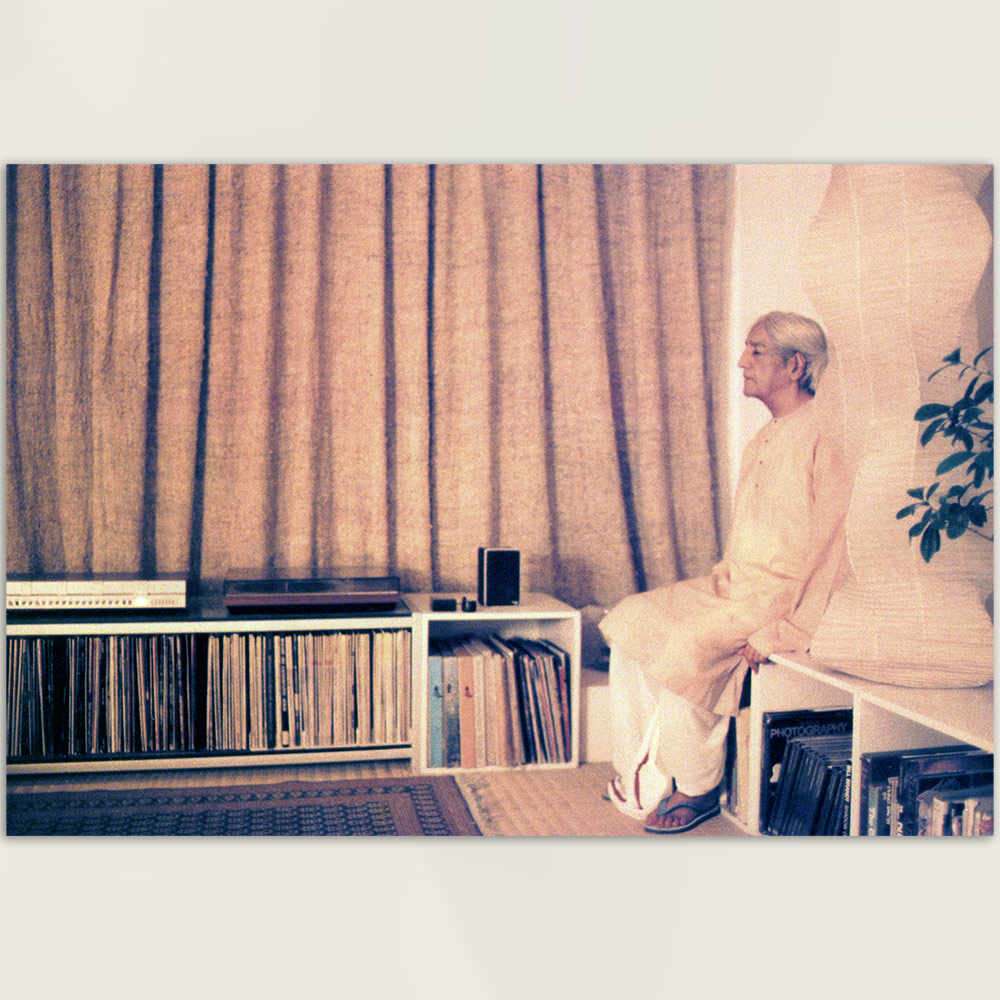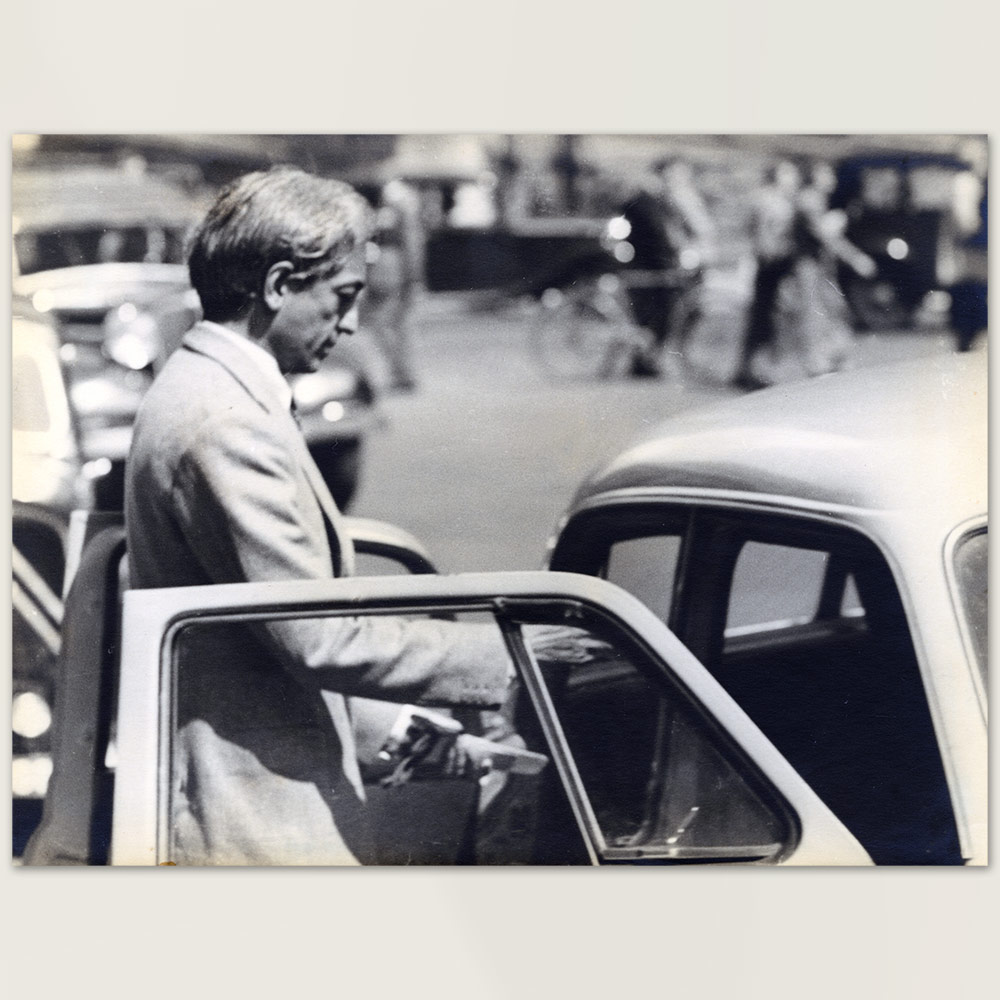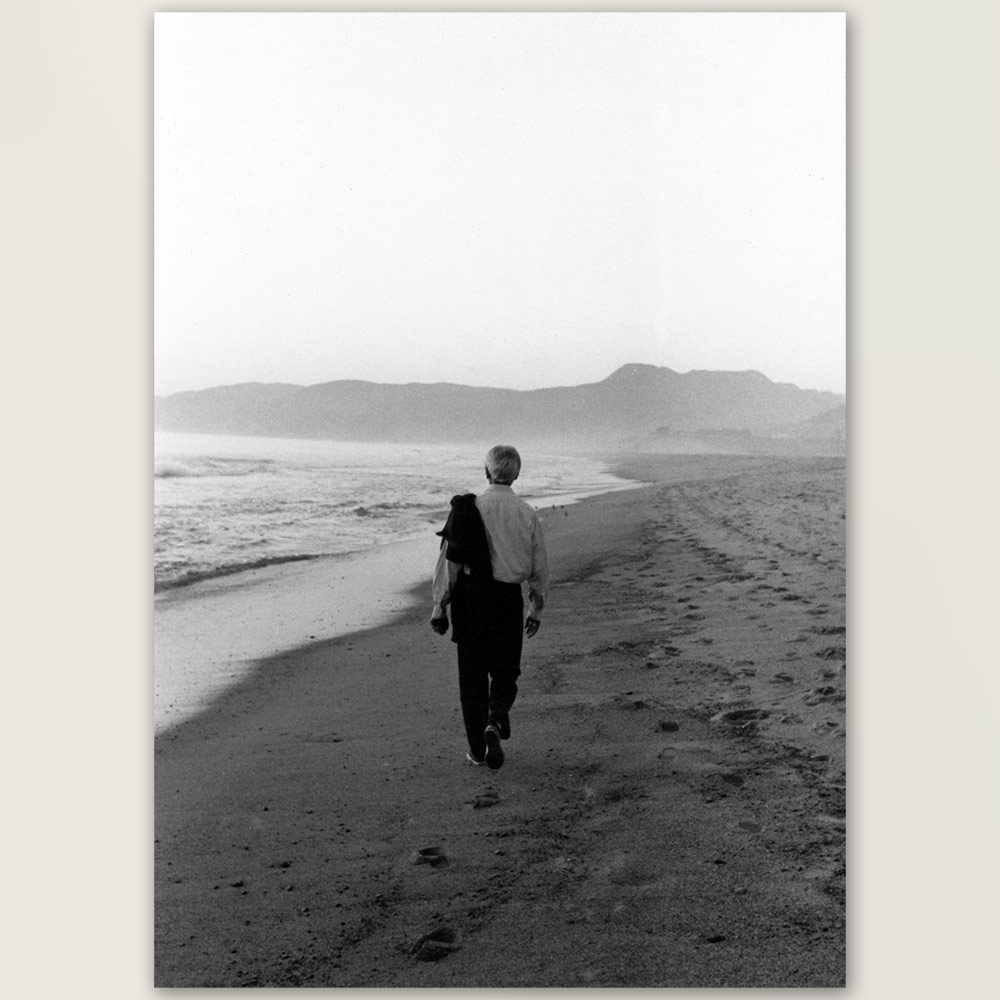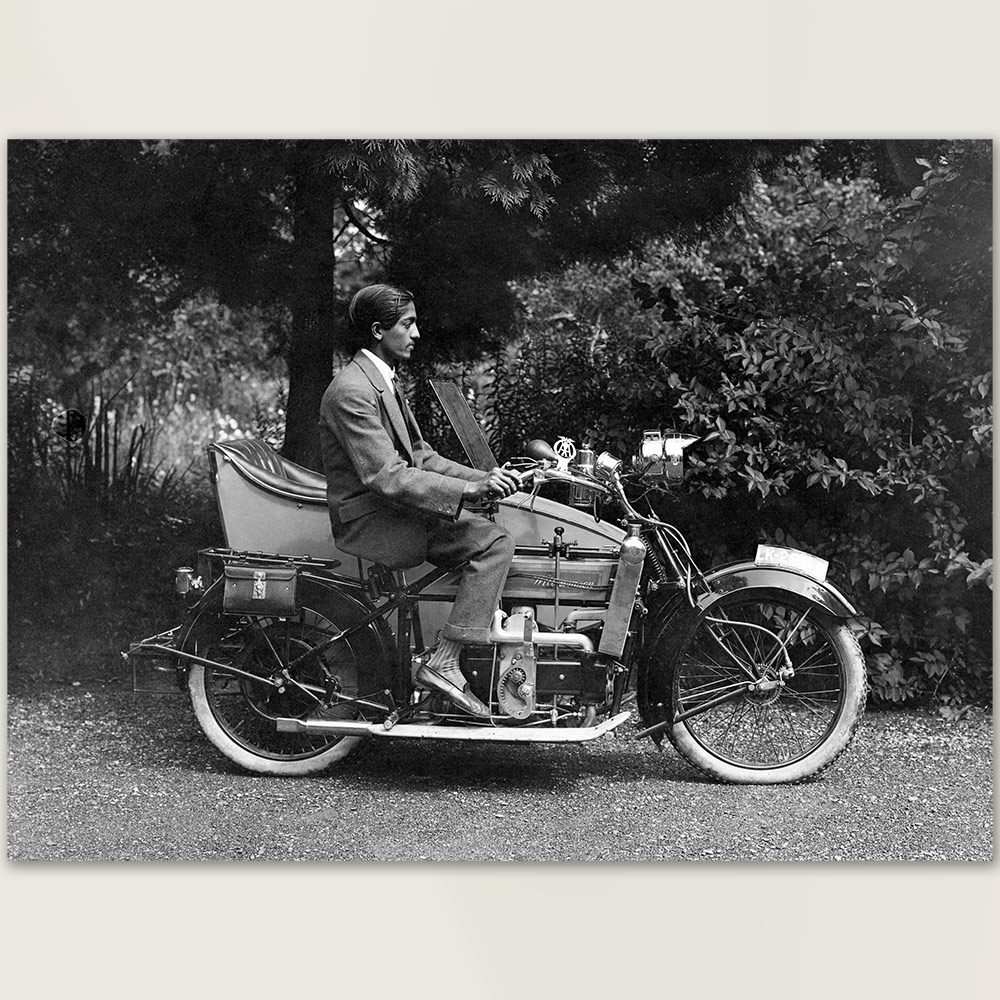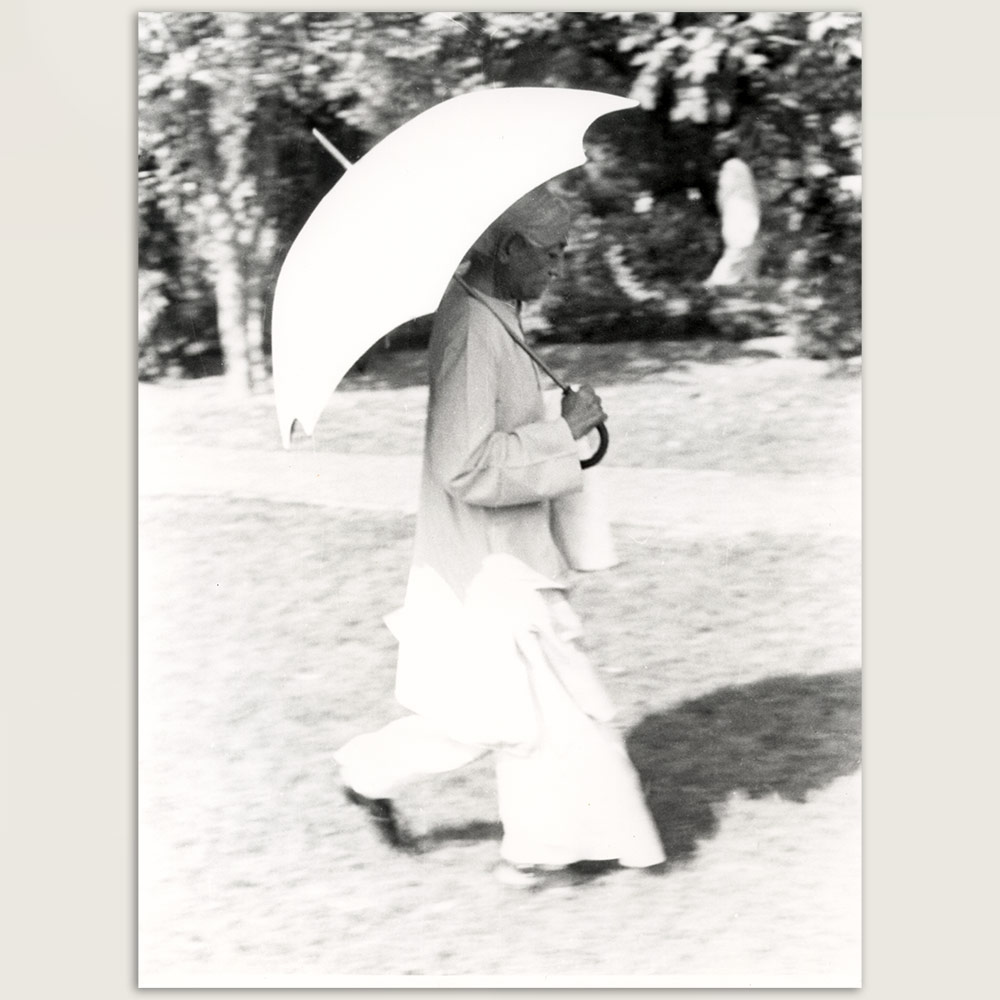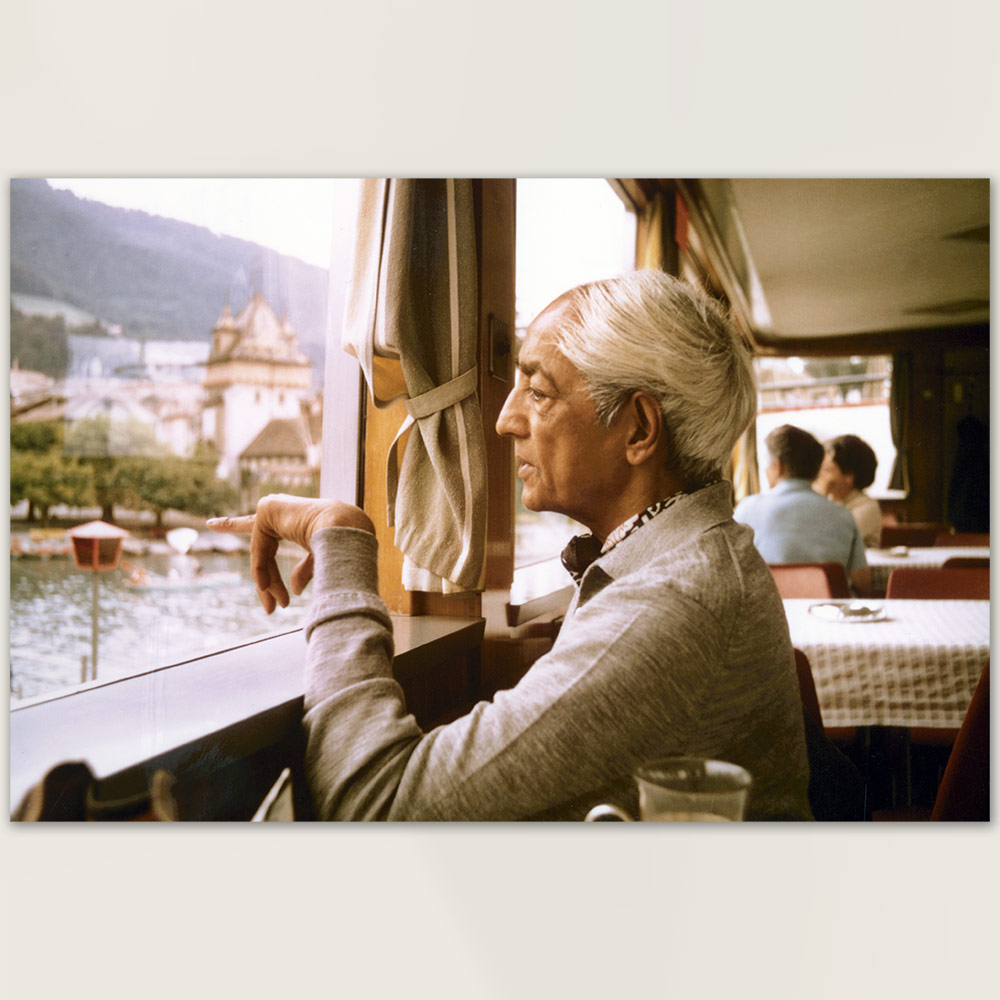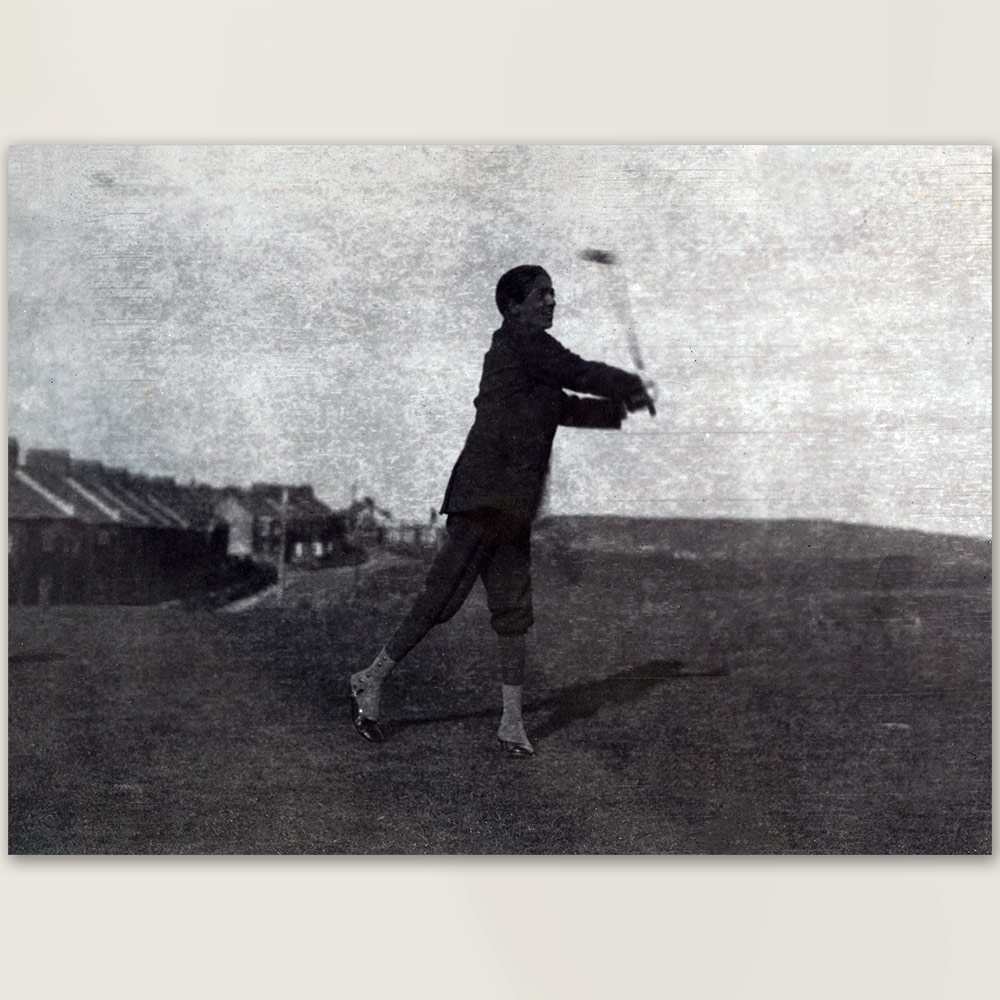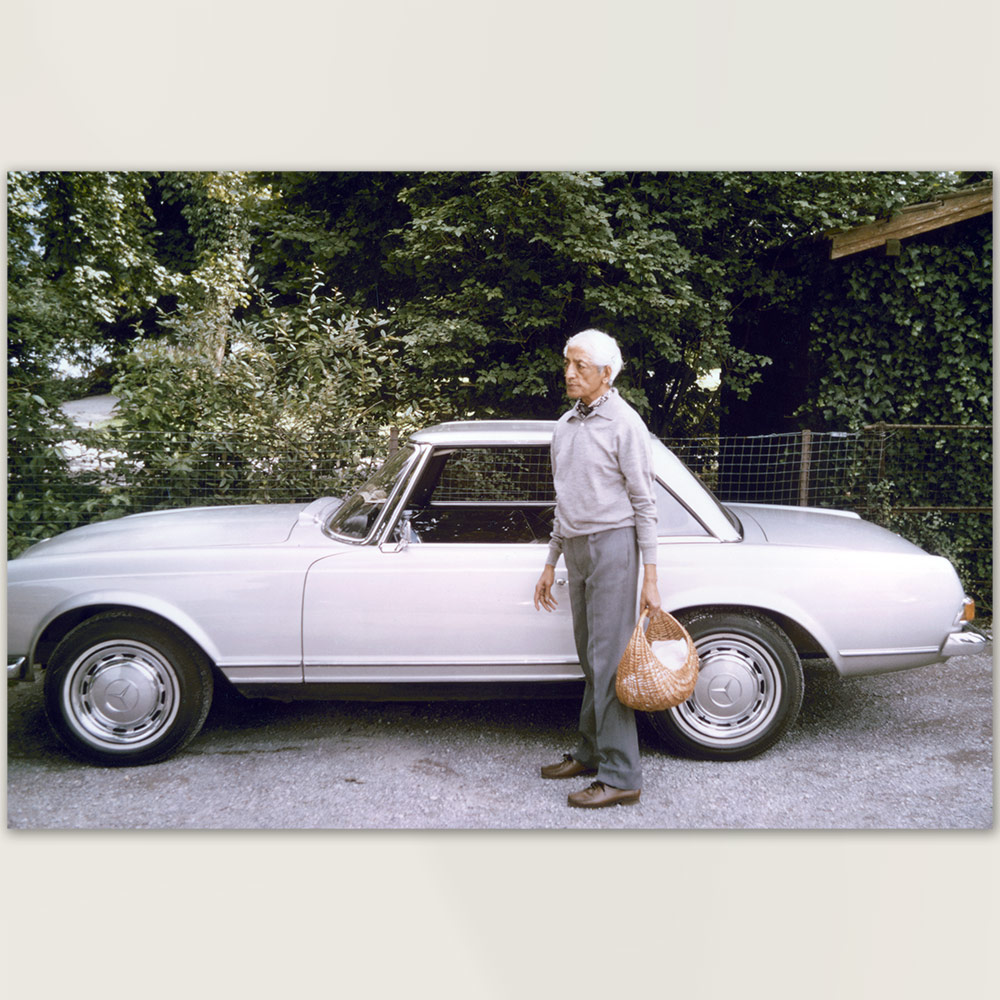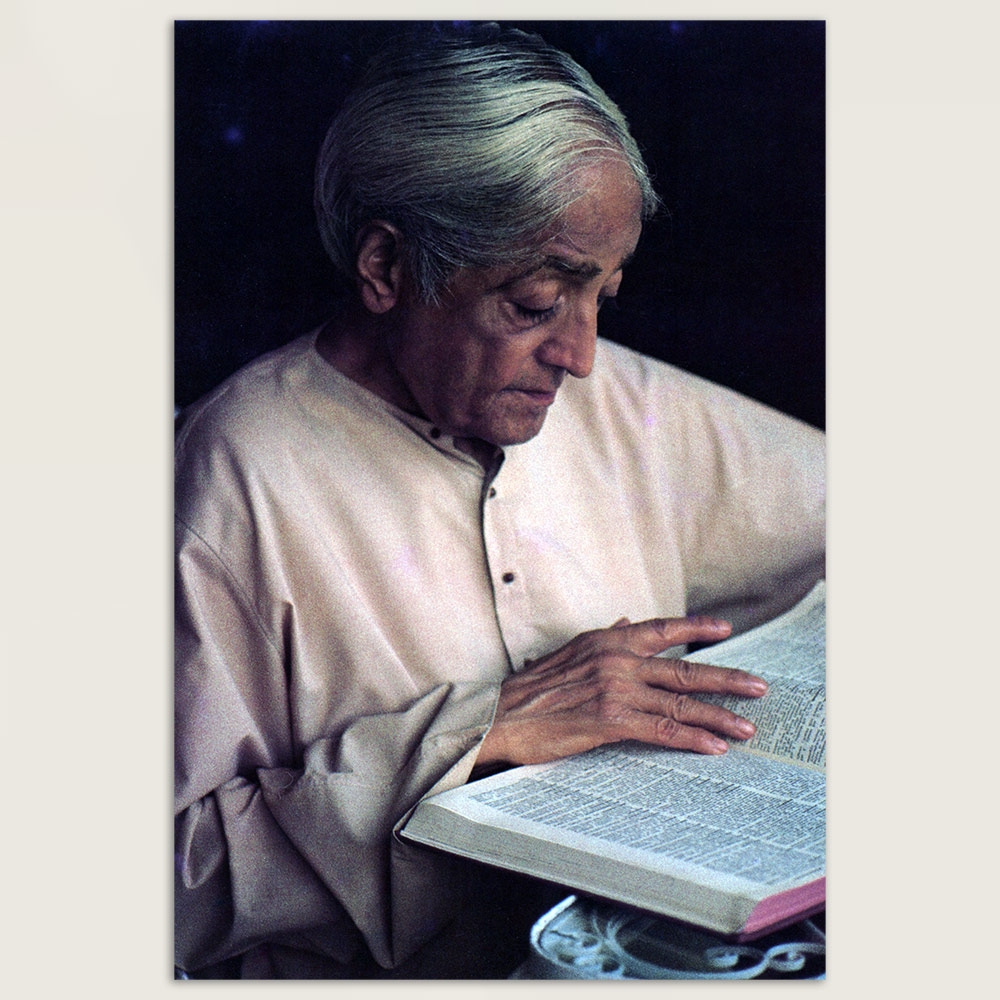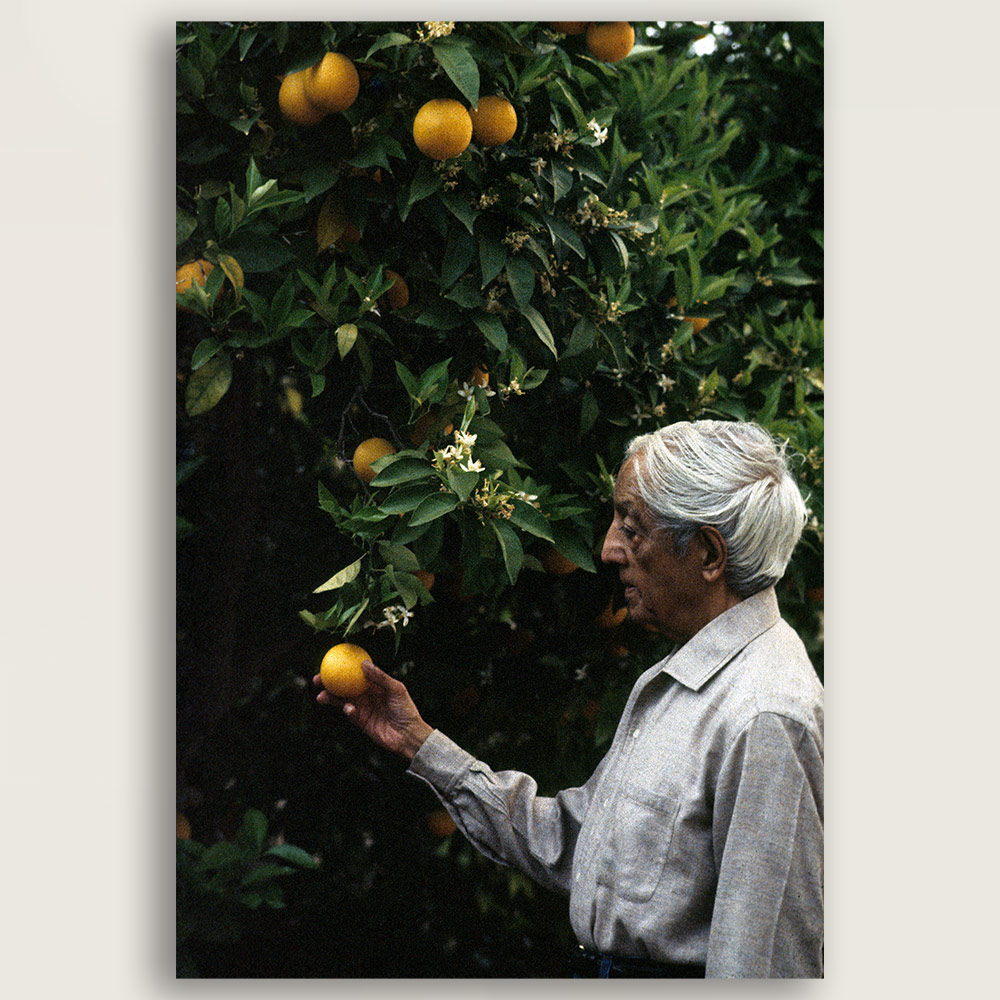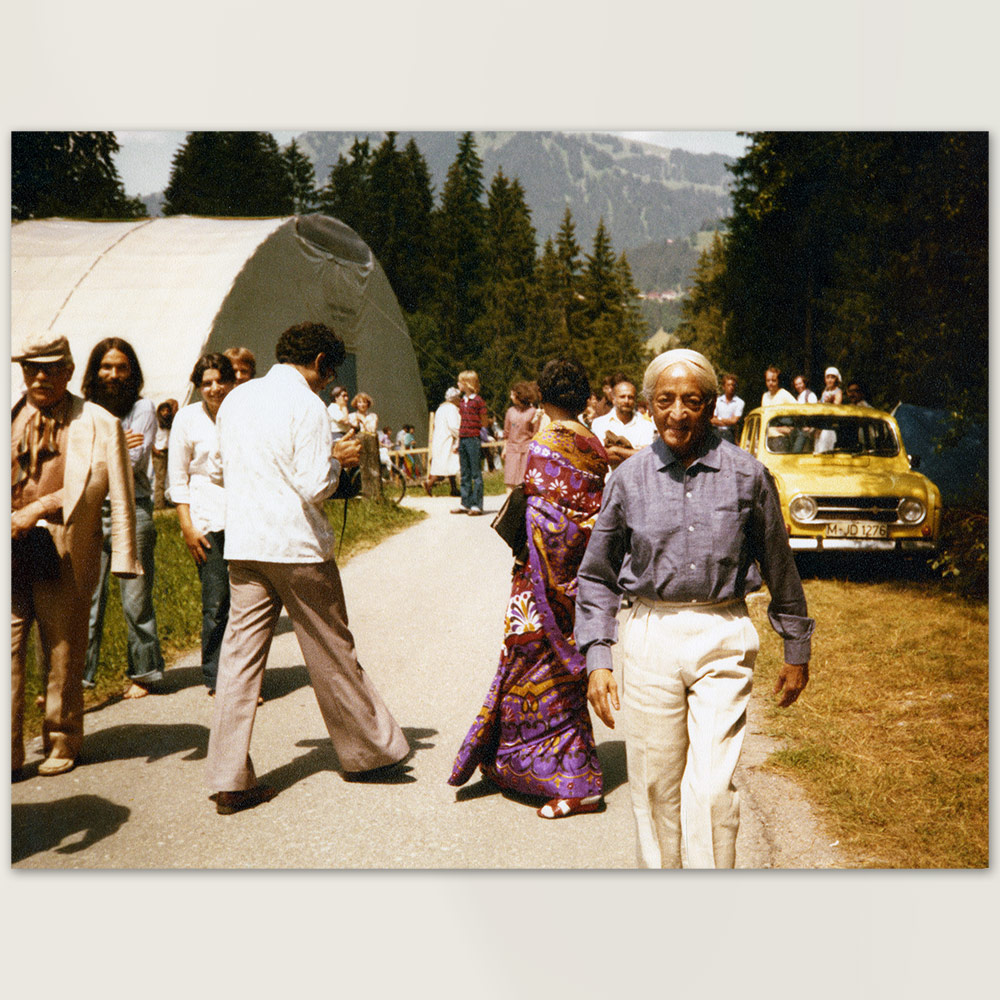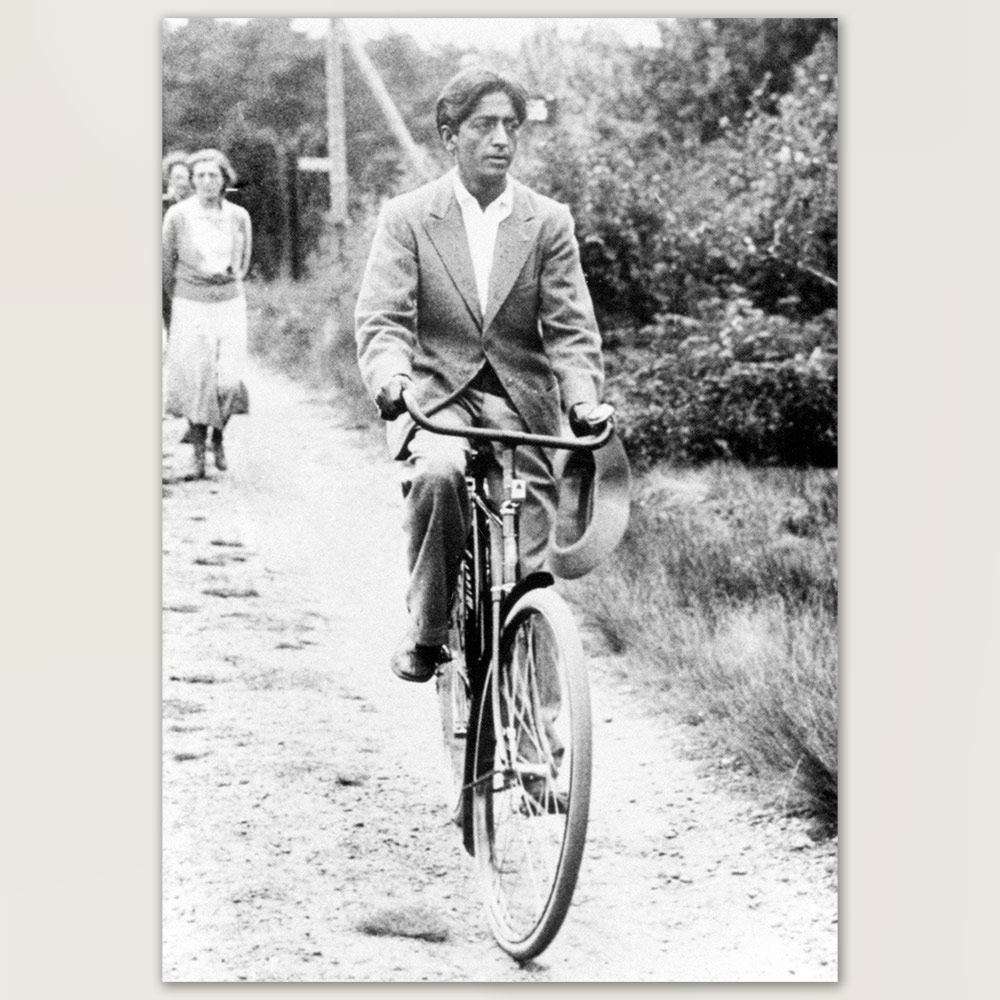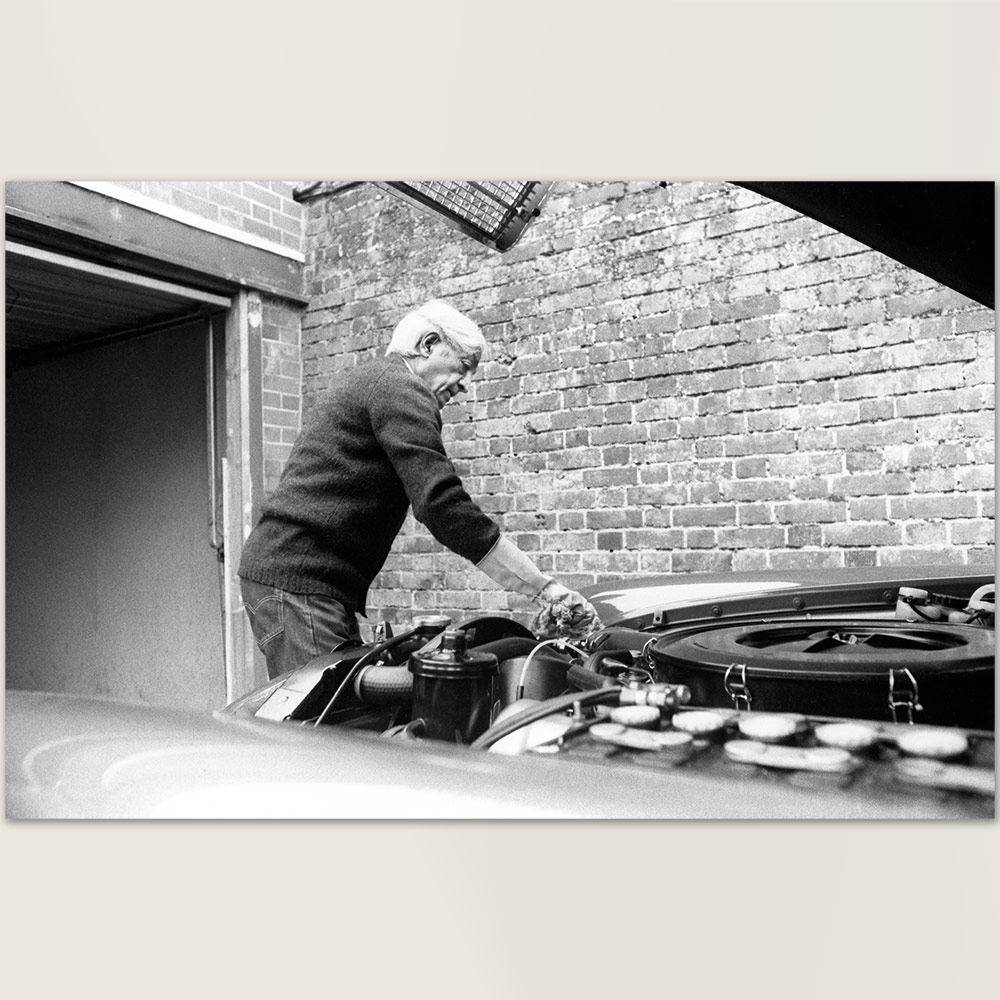
From the Archives, Vol. 7
Volume 6 of From the Archives focussed on photograph portraits of Krishnamurti. This edition highlights some of the more informal photos in our extensive collection of more than 11,000 photographs. A long-term project of the foundation archives has been scanning and cataloguing prints, negatives and slides at high resolution for preservation and to make the collection easier to reference. The 20 photographs presented here help give a more relaxed and complete impression of Krishnamurti and his life outside his role as a speaker. Some pictures may be familiar to many, such as walking on the beach in Malibu or cleaning a car at Brockwood Park; others are released here for the first time. Related quotes accompany the photographs.
Krishnamurti at the food servery at Brockwood Park School in 1978. Photograph by Frances McCann. Krishnamurti often ate in the dining room with the staff and students of the school during the time he was there each year. ‘Will you have a good body, eat the right food, exercise, walk, so that your body becomes extraordinarily alive?’ – Krishnamurti at Rishi Valley in 1982, Discussion 1.
Krishnamurti with bow and arrow at Castle Eerde, Ommen, The Netherlands. The photographer and year are unknown but it was probably taken in the early 1930s. ‘Have you ever played with archery? The slightest movement sends the arrow crookedly. The whole body must be completely harmonious, relaxed to let the arrow fly smoothly.’ – Krishnamurti in Sydney 1970, Talk 2.
Krishnamurti listening to music in Bombay, early 1980s. This photo was taken by Asit Chandmal most probably at his apartment or that of Pupul Jayakar. ‘When you are enjoying something, a conversation, a piece of music, or when reading literature, you listen, and the words, the music, the sound, the silence between two notes, slips in, enters without your struggling to understand.’ – Krishnamurti in Bombay 1948, Talk 7.
Krishnamurti in the 1950s. Pictures of Krishnamurti in an urban setting are relative rare. The location and photographer are unknown, beyond it being in Europe. ‘Life in a city is strangely cut off from the universe; man-made buildings have taken the place of valleys and mountains, and the roar of traffic has been substituted for that of boisterous streams.’ – Krishnamurti, Commentaries on Living 1.
Krishnamurti walking on Zuma beach in Malibu, 1970. Photograph by Mary Zimbalist, who lived nearby at the time and with whom Krishnamurti often walked. ‘As you walked on the beach the waves were enormous and breaking with magnificent curve and force. You walked against the wind, and suddenly you felt there was nothing between you and the sky, and this openness was heaven.’ – Krishnamurti, Meditations 1969.
Krishnamurti on a motorcycle with sidecar in the late 1910s, somewhere in England. Photographer unknown. ‘He enjoyed nothing more than polishing the motorcycle and tinkering with the engine, and, according to Dick Clarke he was a first-class mechanic. He was a rather erratic driver though, and when he took Lady Emily [Lutyens] for a drive in the sidecar, she had to cling to the thought that he was divinely protected.’ – Mary Lutyens, The Years of Awakening.
Krishnamurti walking at Rajghat, Benares in 1978, with a sun umbrella. Photographer unknown. Having had sunstroke, Krishnamurti was careful not to be in strong sunshine for too long, and often shaded himself. ‘Creative happiness is not yours or mine. Creative happiness is like sunshine. If you want to keep the sunshine to yourself, it is no longer the clear, warm life-giving sun.’ Krishnamurti at Rajghat in 1954, Talk 12.
Krishnamurti on a boat in Switzerland, 1972. Possibly at Lake Thun, this photograph was taken by Mary Zimbalist while in the country for the talks. ‘Along the lake, children were shouting with laughter. Through all this movement and bustle there was enchanting beauty, and a strange, all-pervading peace.’ – Krishnamurti, Commentaries on Living 3.
Krishnamurti playing golf in the 1910s, possibly in Scotland where he played in his youth (amongst other places). Photographer unknown. ‘Across the valley there is a long golf course, beautifully kept; we have played on it long ago. One has forgotten the course and the bunkers, but there it still is, very carefully maintained. One sees quite a lot of people with heavy bags playing on it. In the old days, one had a bag of only six clubs, but now there are a dozen. It is getting too professional, too expensive.’ – Krishnamurti to Himself.
Krishnamurti on the train to London, 1980. Photograph by Asit Chandmal. When staying at Brockwood, Krishnamurti would often travel to London for the day to attend appointments and visit his friend and biographer Mary Lutyens. Krishnamurti always dressed according to location and activity, as can be seen in this collection of images. ‘It was a marvellous day, so full of humour and space. The noisy town with its lights and the smooth running train were in this vast silence, and its beauty was everywhere.’ – Krishnamurti’s Notebook.
Krishnamurti in Switzerland, 1972. Photograph by Mary Zimbalist. Taken on the same day as the Lake Thun photograph above, Krishnamurti is seen here with a picnic basket and Mary’s Mercedes-Benz car. ‘You see a car. It has nice lines, is highly polished and has plenty of power. Thought creates the image of you in the car, driving it. So does desire begin, and the source of desire is thought creating the image.’ – The Network of Thought.
Krishnamurti consulting a dictionary in Rishi Valley, 1980. Photograph by Asit Chandmal. Krishnamurti liked to look up the root meaning of words, which he then explored in his talks. ‘The word ‘intelligence’ comes from legere, to read – to read in a different sense, psychologically read, and read objectively what is. All that is implied in intelligence, according to the dictionary.’ – Krishnamurti in Ojai 1977, Discussion 4.
Krishnamurti feeding pigeons, St Mark’s Square, Venice, 1910s. Photographer unknown. Krishnamurti travelled to Italy on different occasions in the 1910s as part of his education in Europe. ‘I was once in Venice, and a cardinal was performing a mass. It was the most beautiful thing, a great sensation. People were genuflecting, crossing themselves – it was great fun. Religions have nothing whatsoever to do with our daily living.’ – Krishnamurti in Ojai 1985, Talk 4.
Krishnamurti with Whisper the Dog at Brockwood Park, 1980s. Photographer unknown. When at Brockwood, Krishnamurti would walk daily in the parkland and local countryside. He was often accompanied by friends and one of the school dogs. ‘Coming over the stile into The Grove, one felt immediately a great sense of peace and stillness. Not a thing was moving. It seemed sacrilegious to walk through it, to tread the ground; it was profane to talk, even to breathe. Even the dog didn’t chase the rabbits.’ – The Beauty of Life – Krishnamurti’s Journal.
Krishnamurti picking oranges outside Pine Cottage in Ojai, 1980. Photograph by Asit Chandmal. ‘One likes these quiet mornings. The oranges are so bright and the leaves, dark green, are shining. There is a perfume in the air from the orange blossom, strong, almost suffocating. There is a different kind of orange to be picked later on, before the summer heat. Now there is the green leaf, the orange and the flower on the same tree at the same time. It is a beautiful world and man is so indifferent to it, spoiling the earth.’ – Krishnamurti to Himself.
Krishnamurti at the Saanen gatherings, 1980. This photograph by Maj-Britt Wreibo gives a good idea of the scene surrounding his talks and discussions in Switzerland. Krishnamurti, looking relaxed, may well have just finished a talk when this was taken. ‘Why hate rather than love, why greed and not generosity, why self-centred activity and not open total action? Why be mean when there are soaring mountains and flashing streams? Why jealousy and not love? Why?’ – Krishnamurti’s Notebook.
Krishnamurti cycling at the Star Camp in Ommen, 1928. Photographer unknown. Another gatherings scene, this one 52 years earlier, and one year before Krishnamurti’s split from the Theosophical Society. ‘If one wants to learn cycling, you have to learn, memorise, learn to balance and so on; knowledge has its place. But it cannot bring about a psychological revolution in man. Then what will?’ – Krishnamurti in San Francisco 1975, Talk 2.
Krishnamurti relaxing in flight, 1980. Photograph by Asit Chandmal. Krishnamurti must have travelled a incredible number of miles in his lifetime. Although the number of locations he spoke at decreased in later years, here at 85 years of age he was still flying multiple times per year. ‘From the bullock cart to the jet plane there is a tremendous evolutionary process of vast accumulated knowledge, which involves time. Apart from that, is there a process, a gradualness, a continuity of change, or is there a psychological revolution in which time doesn’t exist at all?’ Krishnamurti in New Delhi 1970, Talk 3.
Krishnamurti cleaning a car at Brockwood Park in 1972. Krishnamurti had a lifelong interest in cars, in his youth taking engines apart and reassembling them. Even if they were not his own, he took good care of those he used. ‘It was a smooth road, the hum of the motor was steady, and the traffic was very light. There was an intense awareness of the country, of the occasional passing car, of the road signs, of the clear blue sky, of the body sitting in the car; but the mind was very still. It was not the quietness of exhaustion or of relaxation, but a stillness that was very alert.’ – Commentaries on Living 1.
Krishnamurti at Adyar Beach, Madras, 1980. Photograph by Asit Chandmal. This photograph was taken not far from where Krishnamurti was ‘discovered’ by the theosophists all those years before. ‘Krishnamurti must have looked an unlikely candidate: undernourished, with crooked teeth and a vacant expression. But they said the child had an aura of unselfishness; he was the chosen one.’ – The Role of a Flower.
A gallery of further photographs is also available. The next edition of From the Archives (Volume 8) features photographs of Krishnamurti with some of those associated with him.



